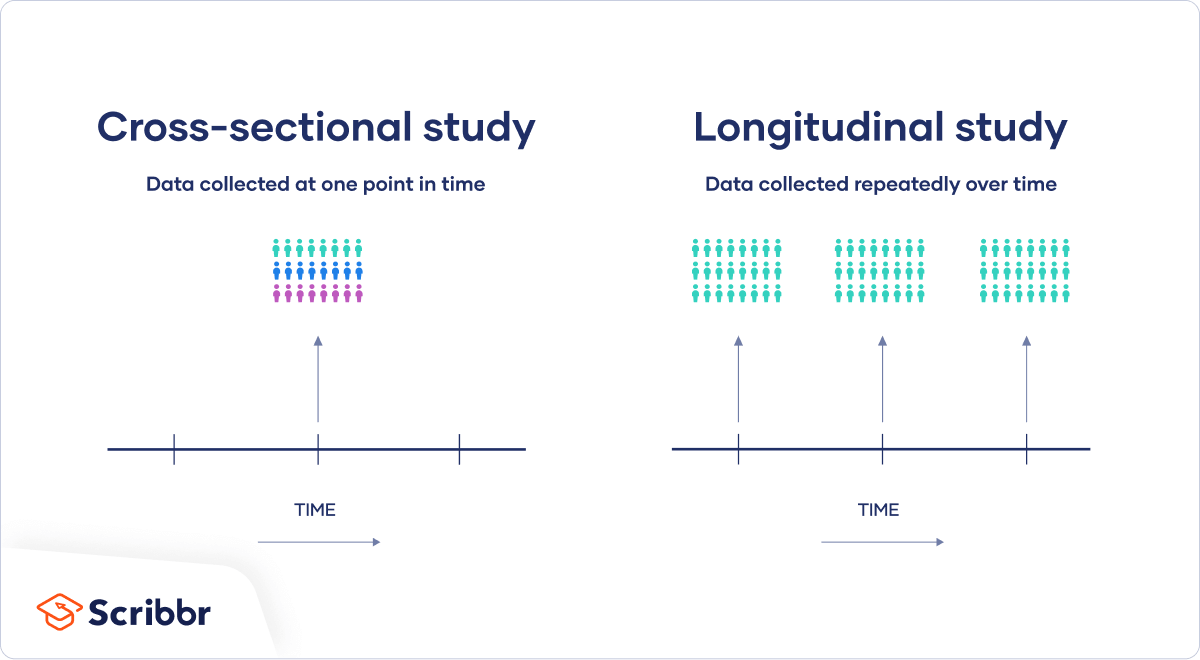Longitudinal Study | Definition, Approaches & Examples
In a longitudinal study, researchers repeatedly examine the same individuals to detect any changes that might occur over a period of time.
Longitudinal studies are a type of correlational research in which researchers observe and collect data on a number of variables without trying to influence those variables.
While they are most commonly used in medicine, economics, and epidemiology, longitudinal studies can also be found in the other social or medical sciences.
How long is a longitudinal study?
No set amount of time is required for a longitudinal study, so long as the participants are repeatedly observed. They can range from as short as a few weeks to as long as several decades. However, they usually last at least a year, oftentimes several.
One of the longest longitudinal studies, the Harvard Study of Adult Development, has been collecting data on the physical and mental health of a group of Boston men for over 80 years!
Longitudinal vs cross-sectional studies
The opposite of a longitudinal study is a cross-sectional study. While longitudinal studies repeatedly observe the same participants over a period of time, cross-sectional studies examine different samples (or a “cross-section”) of the population at one point in time. They can be used to provide a snapshot of a group or society at a specific moment.
Both types of study can prove useful in research. Because cross-sectional studies are shorter and therefore cheaper to carry out, they can be used to discover correlations that can then be investigated in a longitudinal study.
You then decide to design a longitudinal study to further examine this relationship in men. Without the cross-sectional study first, you would not have known to focus on men in particular.
How to perform a longitudinal study
If you want to implement a longitudinal study, you have two choices: collecting your own data or using data already gathered by somebody else.
Using data from other sources
Many governments or research centers carry out longitudinal studies and make the data freely available to the general public. For example, anyone can access data from the 1970 British Cohort Study, which has followed the lives of 17,000 Brits since their births in a single week in 1970, through the UK Data Service website.
These statistics are generally very trustworthy and allow you to investigate changes over a long period of time. However, they are more restrictive than data you collect yourself. To preserve the anonymity of the participants, the data collected is often aggregated so that it can only be analyzed on a regional level. You will also be restricted to whichever variables the original researchers decided to investigate.
If you choose to go this route, you should carefully examine the source of the dataset as well as what data is available to you.
Collecting your own data
If you choose to collect your own data, the way you go about it will be determined by the type of longitudinal study you choose to perform. You can choose to conduct a retrospective or a prospective study.
- In a retrospective study, you collect data on events that have already happened.
- In a prospective study, you choose a group of subjects and follow them over time, collecting data in real time.
Retrospective studies are generally less expensive and take less time than prospective studies, but are more prone to measurement error.
Advantages and disadvantages of longitudinal studies
Like any other research design, longitudinal studies have their tradeoffs: they provide a unique set of benefits, but also come with some downsides.
-
Advantages
Longitudinal studies allow researchers to follow their subjects in real time. This means you can better establish the real sequence of events, allowing you insight into cause-and-effect relationships.
Longitudinal studies also allow repeated observations of the same individual over time. This means any changes in the outcome variable cannot be attributed to differences between individuals.
Prospective longitudinal studies eliminate the risk of recall bias, or the inability to correctly recall past events.
-
Disadvantages
Longitudinal studies are time-consuming and often more expensive than other types of studies, so they require significant commitment and resources to be effective.
Since longitudinal studies repeatedly observe subjects over a period of time, any potential insights from the study can take a while to be discovered.
Attrition, which occurs when participants drop out of a study, is common in longitudinal studies and may result in invalid conclusions.
Other interesting articles
If you want to know more about statistics, methodology, or research bias, make sure to check out some of our other articles with explanations and examples.
Methodology
Frequently asked questions about longitudinal studies
- What is the difference between a longitudinal study and a cross-sectional study?
-
Longitudinal studies and cross-sectional studies are two different types of research design. In a cross-sectional study you collect data from a population at a specific point in time; in a longitudinal study you repeatedly collect data from the same sample over an extended period of time.
Longitudinal study Cross-sectional study Repeated observations Observations at a single point in time Observes the same group multiple times Observes different groups (a “cross-section”) in the population Follows changes in participants over time Provides snapshot of society at a given point - How long is a longitudinal study?
-
Longitudinal studies can last anywhere from weeks to decades, although they tend to be at least a year long.
- What are the pros and cons of a longitudinal study?
-
Longitudinal studies are better to establish the correct sequence of events, identify changes over time, and provide insight into cause-and-effect relationships, but they also tend to be more expensive and time-consuming than other types of studies.
- What is an example of a longitudinal study?
-
The 1970 British Cohort Study, which has collected data on the lives of 17,000 Brits since their births in 1970, is one well-known example of a longitudinal study.
Cite this Scribbr article
If you want to cite this source, you can copy and paste the citation or click the “Cite this Scribbr article” button to automatically add the citation to our free Citation Generator.
Thomas, L. (2023, June 22). Longitudinal Study | Definition, Approaches & Examples. Scribbr. Retrieved November 27, 2023, from https://www.scribbr.com/methodology/longitudinal-study/




